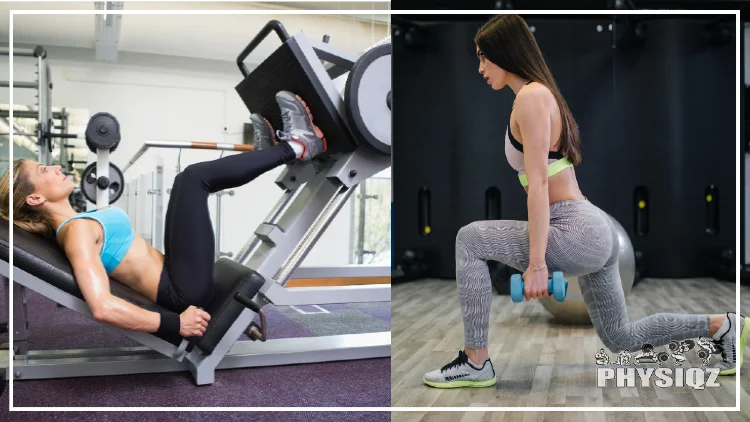
A reverse hack squat alternative can be just as beneficial, if not more beneficial than the hack squat since many of the substitutes below don’t load the spine, add emphasis the the quads or glutes (depending on your goals) and more importantly, may allow you to feel and engage a desired muscle more.1
For example, the juicy reverse hack squat alternate exercise that top lifters are using — also known as the belt squat — offers a huge stimulus to the quads while keeping fatigue low since it doesn’t load the spine like standards hack squats, reverse hack squats, or even barbell squats.
If your gym doesn’t have a belt squat machine don’t worry because there’s + 21 more exercises to choose from.
The Belt Squat Is the #1 Reverse Hack Squat Alternative
The back squat places the load on the lifter’s back, whereas the belt squat machine anchors the load at the hips, allowing for squats with relative safety.
As a result, this apparatus puts less strain on the back and can help lifters enhance their squatting technique before progressing to barbell squats. They may also serve as an accessory to the squat to improve leg muscle and strength.
Belt squats primarily target the quads and hamstrings with less stress on the lower back and the trunk muscles; the glutes and hip extensors are less activated as opposed to the reverse hack squat where they are one of the primary muscles.2
Trunk muscles consist of the abdominal muscles, lats, erector spinae and iliopsoas muscles.
How To Perform Belt Squat
Get on the machine, adjust the belt on your waist and ensure knees stay forward during the movement to allow the quads to be properly engaged.
Act as if you’re dropping straight down, let your knees come over your toes, and don’t lean back to lessen glute activation.
Just like the belt squat, the remaining 21 reverse hack squat alternatives serve to provide the benefits that the reverse hack squat do and are great to add in a little variation.
21 More Reverse Hack Squat Alternatives
There are a number of alternatives that are available for this machine based accessory to the squat including the belt squat, leg press, good mornings, front squat, leg press, deadlifts and reverse lunges.
The hardest muscle to grow, including the glutes, quads, hamstrings, and calves, are primarily targeted by the reverse hack squat. They do not require the need for stabilization from the lifter like the barbell squat.
1. Barbell Hip Thrust
The barbell hip thrust is performed in a supine position (laying horizontally) but with the back across a bench. It targets primarily the gluteus muscle and elicits greater activation of the extensor muscles of the hip, but also recruits the hamstrings, quads and calves.
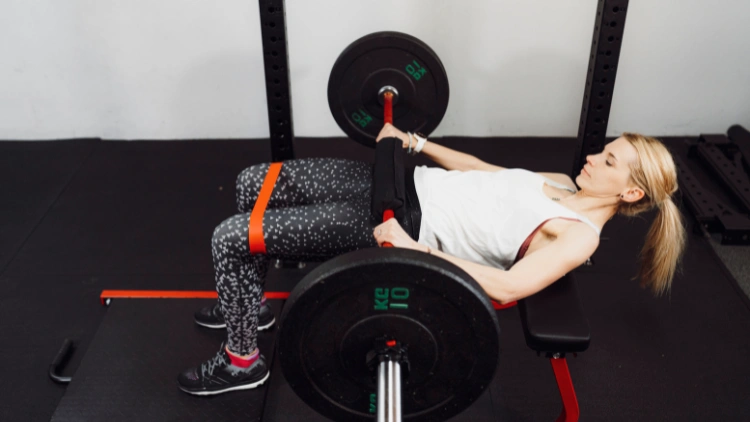
Source: Ziga Plahutar via Canva.com3
They are also included in leg workouts as an accessory to strengthen the glutes.4 They are ideal for enhancing sprint times for athletes.
How To Perform Barbell Hip Thrust
Place the barbell at the crease of the hips, with the shoulders and upper back against the bench while having the knees bent and feet in front and hands holding the bar to keep it stable.
Raise the bar using glutes by driving feet into the floor, hold at the top of the second with an emphasis on squeezing the glutes. Lower to the starting position and repeat.
Note, there’s no need to put the lower back into flexion and it’s best to keep a neutral spine position. Or in other words, don’t tilt your hips forward when you’re at the top of this movement.
2. Barbell Walking Lunge
The barbell walking lunge, a classic exercise from the golden era of bodybuilding, targets the quads and remains a staple lower body workout.
It also works the abs, hamstrings, glutes, calves, traps, upper back and adductors and unlike the reverse hack, involves movement in a forward motion.
They are a variation of the lunge and an advancement of the barbell lunge, serving as a complete leg builder ideal for inclusion in a workout plan for skinny guys to build muscle fast. Barbell walking lunges also have a cardio aspect to them and can be done with a set number of reps or distance to cover.
How To Perform Barbell Walking Lunge
They are done by placing a barbell on the traps as would be done in a squat. The lifter should place the feet shoulder apart and begin by stepping forward with one leg while allowing both knees to bend simultaneously and then proceed to descend until the back knee barely touches the ground.
Then drive to the foot at the front into the ground while extending the knee as to stand up fully to the starting position. Repeat with the other leg and do the desired reps.
3. Cable Pull-Through
Considered a gateway to deadlifts, this compound movement effectively targets the posterior chain muscles, including the glutes, hamstrings, calves, lats, and the muscles along the spine (spinae).
Cable pull throughs help the lifter learn how to activate the glutes and they differ from reverse hacks in that they use a cable machine but they are similar in movement, however they don’t target the quads but are glute and hamstring intensive.
How To Perform Cable Pull-Through
Using a cable machine, lower the pulley to the lowest position and pick the ideal weight. Face away from the machine, and grab the pulley with palms facing each other in between the legs. A few steps need to be taken away from the machine to allow the pulley to lift the weight.
Take a wider than shoulder width stance and the movement is initiated by bending at waist and a slight bend at the knee while keeping a neutral spine and push the glutes through for a 1-2 second squeeze.
4. Deadlift
Deadlifts are an effective compound movement that involves lifting a weighted barbell or kettlebell off the floor by hinging back at the hips. It varies from reverse hack squats since the weight is picked up off the floor and it also does not use a machine.
The deadlift targets the posterior chain, the lower and upper back, core, hips, core and to a lesser extent the quads.
They should be a staple for a lifter’s deadlift workout program, as they significantly enhance strength in the major muscle groups, translating to improved performance in other exercises and daily activities.5
How To Perform Deadlift
Stand behind the barbell with feet about shoulder width with shins almost touching the bar, with the bar being above the mid foot. Maintain a lifted chest, slightly sink back at the hips, and keep a neutral spine as you bend forward to grip the bar, choosing between hook grip vs mixed grip.
When the bar is being gripped, ensure feet and are flat into the ground and hips sunk back. Push with the legs as if pushing the floor away and rise with the barbell while ensuring a neutral spine, tight abs and keeping the bar very close to the body.
Place the weight back down and do not bounce the weight, it should come to a dead stop.
5. Deficit 25’s Deadlift
The deficit 25’s deadlift is a variation of the conventional deadlift that uses smaller plates and lighter weights which makes it easier to do and also perfect the form of the heavier deadlifts.
It also allows for higher reps due to the lighter weight and allows beginners in particular to master the hip hinge—movement when the body is bent downwards in half by bending slightly at the knees with a straight back and hips pushed backwards.
How To Perform Deficit 25’s Deadlift
This reverse hack squat alternative exercise is done in the same way as the conventional deadlift but the lower back should not round at the bottom.
6. Deficit Deadlift
These types of deadlifts are done off a surface that is elevated which results in an increased range of motion—in other words the bar travels a longer distance.
This deficit creates a disadvantage for the starting mechanics and the loading for this type of deadlift is lower than conventional deadlifts with the rule of thumb being 10-25 % less weight than conventional deadlifts.
Enhancing strength off the floor, particularly in the initial third part of the deadlift, this exercise also prolongs time under tension, enhances lifting posture, and strengthens the posterior chain, which is where you should feel deadlifts.
How To Perform Deficit Deadlift
They are performed in the same way as conventional deadlifts, but the surface is raised by 1 to 4 inches off the ground and a metal weight plate can foot the bill for this requirement. If the lower back is rounded to reach the weight, then the deficit and height is too high and should be adjusted.
7. Dumbbell Walking Lunge
Similar to barbell walking lunges, these use a dumbbell instead which makes them beneficial since they are working the muscles unilaterally which helps correct any imbalances when using a barbell.
Like its counterpart, the dumbbell walking lunge strengthens the leg muscles, in particular the hamstrings and glutes.
In addition to targeting the core muscles and quads, this exercise also improves balance and coordination and contributes to the hardening of leg muscles.
How To Perform Dumbbell Walking Lunge
Holding two dumbbells on either side, perform these like the way the barbell walking lunges are done but ensure that the dumbbells tendency to pull the lifter down and forward are resisted. It is imperative to stay upright to maintain full glute activation.
8. Machine Glute Kickback
As the name infers, machine glute kickbacks primarily target the gluteus which happens to be the largest muscle in the human body.
They are a form of isolation exercise that uses a cable machine or a glute machine to unilaterally activate each individual glute unlike the reverse hack that is not unilateral and actively targets the quads as well.
It does to some extent target the hamstrings, calves and quads which help maintain stability and balance throughout the movement. Machine glute kickbacks strengthen and tone the glutes, reduce backaches and increase balance due to having stronger glutes.
How To Perform Machine Glute Kickback
Attach an ankle cuff with the cable pulley lowered, hold the machine for support while hinging at hips and maintain an upright chest. Engage the core, with knees bent slightly and squeeze the glutes to pull the leg backwards while keeping the other leg firmly planted.
Return the leg slowly and repeat for desired reps, then switch to the other leg. These can also be done on a glute machine.
9. Machine Hip Thrust
Similar to the barbell hip thrust, this exercise uses a machine such as the Booty Builder to primarily target the glutes but also the hamstrings which extend the hip joint and the adductor magnus (inner thigh muscles) by providing stability.6
The machine can be weighted to add intensity and unlike the reverse hack squat, this does not target the quads.
How To Perform Machine Hip Thrust
They have the same movement pattern as with the barbell hip thrust, but this time the lifter places himself in the machine, with the weight on the crease of the hips and they thrust with glutes and hips and squeeze at the top and hold for 1 or 2 seconds.
Again, keep a neutral spine throughout the movement and don’t tilt the hips.
10. Reverse Lunge
Reverse lunges do not use any machines and are a unilateral exercise that primarily target the glutes, hamstrings and core muscles. They are a variation of the lunge and place a decreased amount of stress on the joints by giving more stability in the front leg.
Reverse lunges are ideal for individuals with constrained hip mobility, knee issues or have challenges with balance. They help improve muscle balances since they are a unilateral exercise.
How To Perform Reverse Lunge
Stand with feet shoulder width and hands at side or holding dumbbells or a kettlebell. With the right foot, step back roughly one and half times the stride length and land with the ball of the foot with the heel elevated. The back leg then should be lowered until it barely touches the ground and creates a 90 degree angle in the front leg.
To finish the movement, push the heel and mid foot into the ground of the front leg to a standing position by aligning the right foot back with the left to complete one rep.
11. Single Leg Hip Thrust
Like the hip thrust, the single leg thrust is a unilateral exercise that activates the glutes which are the primary movers and the quads which don’t have an active role as they do with reverse hack squat, hamstrings, adductors and the mid and lower back muscles that are supportive to the movement. Unlike reverse hack squats, they do not use a machine and the lifter is in a supine position with upper back and shoulders against a bench.
They are beneficial for correcting muscle imbalances and can be a valuable addition to a beginner hypertrophy program.
How To Perform Single Leg Hip Thrust
The movement is similar to the barbell hip thrust, but is done with one leg at a time with the barbell resting on the active leg and the other leg extended out and slightly bent at the knee. It is a very challenging exercise to perform and should be done with little weight.
12. Split Squat
The split squat is a unilateral compound movement similar to the lunge except that split squat places a greater emphasis on the muscles at the front leg working while the back leg relaxes in a majority of the movement.
The split squat is a great reverse hack squat alternative because it is both quad and glute intensive but also works the hamstrings and hip flexors. They can be done with weights to increase intensity and are great at addressing muscle imbalances.
How To Perform Split Squat
Using a bench to place the resting foot, standing in a split stance with the front heel being 2-4 feet in front of the back foot. The lifter should square the hips and maintain a tall upright posture. While engaging the core, begin downward movement by bending at the hip and knee simultaneously on the leg that is not rested until the thighs are parallel to the floor.
Pause for a second or two and then rise with chest up and squeeze on the glutes while hips and knees are straightening to reach starting position and repeat until desired rep range. Repeat for the other leg.
13. Sumo Deadlift
Sumo deadlifts are similar to conventional deadlifts with the exception of having a wider stance and as a result have a smaller range of motion since the bar has to travel a smaller distance. This is a result of the lifter squatting lower due to a wider leg stance.
They target the posterior chain and activate the quads more so than the conventional deadlift; in this case they share a similarity with reverse hack squats.7 Sumo deadlifts place less stress on the spine than conventional deadlifts.
How To Perform Sumo Deadlift
Performed similarly to deadlifts but with a wider-than-shoulder-width stance and toes pointing outwards, they can be executed wearing deadlift shoes or barefoot. Ensure chest is up, hips down and bar very close to the body and stand all the way up and always stop and start the bar at the bottom.
14. Sumo Deficit Deadlift
The sumo deficit has a deficit similar to the conventional deficit deadlift but is done with a sumo stance and a lighter weight typically 10-25 % less weight than the sumo deadlift. This exercise targets the same muscles as the sumo deadlift and enhances the starting strength of the lifter due to the height deficit.
How To Perform Sumo Deficit Deadlift
Similar to the sumo deadlift, it allows the lifter to get low but the lifter should always keep the back tight and not allow it to round. If the back rounds, then they will need to use less of a deficit—a higher weight than the 25 lbs. plate such as the 35 lbs. plate.
15. Sumo Squat
The sumo squat is a variation of the back squat and like the deadlifts, are done with a wide stance of the legs hence the name sumo since they do mimic sumo wrestlers. Sumo squats primarily engage the quads, glutes, hamstrings, calves—the inner thighs are recruited more intensely than regular squats.
They are similar in movement to reverse hack squats but without a machine, since the body is moving in a vertical plane. Sumo squats can be done with a barbell, dumbbell or kettlebell to increase resistance.
How To Perform Sumo Squat
The technique of the performance of the sumo squat is similar to that of the conventional with the exception of placing the legs at a wider stance than the shoulders. Place the bar on the traps, ease back and down with chest out and go as deep as possible without rounding the back which is typically just around or below parallel.
16. Trap Bar Deadlift
Trap bar deadlift is performing the deadlift with a trap bar also known as a hex bar. The trap bar allows the lifter to lift heavier weights, placing less stress on the spine and makes it easier to lift with correct form.8
Similar to the reverse hack squat, this exercise emphasizes the engagement of the quads more than the traditional deadlift, while also activating other trap bar deadlift muscles such as the glutes, posterior chain, and core. Unlike the reverse hack squat, it does not employ a machine.
How To Perform Trap Bar Deadlift
Grab right in the middle of the trap bar while hinging at the hips and placing hips to the back. Push into the ground while keeping the core engaged and lift the bar up.
17. Good Mornings
Good mornings are a compound movement similar to Romanian deadlifts but the bar is rested on the back as in a squat. They primarily target the glutes and hamstrings but also target the other muscles that make up the posterior chain.
Good mornings allow the lifter to master the hip hinge and are also great for posture. They are different from reverse hack squats in that they don’t target the quads.
How To Perform Good Mornings
Place the bar on the back slightly below the shoulders and make sure that the scapula (shoulder blades) are retracted which also helps engage the core. While some people keep the head up, it is better to keep the chin tucked in and ensure that the head and the spine are aligned.
The downward movement should be done by hinging at the hips backwards and continuing this movement until the body is between 30 and 45 degrees from the ground. Maintain neutral spine, squeeze glutes to initiate the hips traveling forward to get back into the starting position.
18. Front Squat
After the belt squat, the front squat is an ideal alternative. It demands more mobility than the back squat and the lifter cannot carry as much weight as they would with a back squat. Like the back squat, they recruit the quads, calves, glutes, hips and to some extent, the hamstrings.
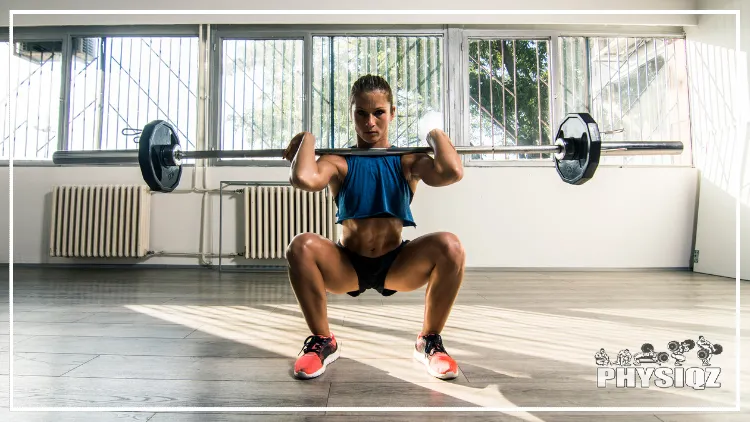
Source: mihailomilovanovic via Canva.com9
While more quad-dominant than back squats, they are particularly beneficial for individuals with knee issues such as meniscus tears. Incorporating them into workout routines adds volume to leg workouts, which is crucial for preventing the phenomenon of getting stronger but not bigger in leg muscles.10
How To Perform Front Squat
The barbell is loaded and rested on the shoulders and the lifter will need to hook the fingers in an underhand grip outside the shoulders while pushing elbows up.
They initiate the movement by bending at the knees and hips simultaneously, keeping elbows as high as possible and going up and down.
19. Front Squat Cross Grip
These exercises closely resemble the front squat, differing only in how the barbell is positioned on the shoulders.
Front squat cross grips involve crossing the arms and positioning each hand on the barbell which is placed on the shoulders—the fingers only act to stabilize the bar with the elbows helping in keeping the barbell on the shoulders.
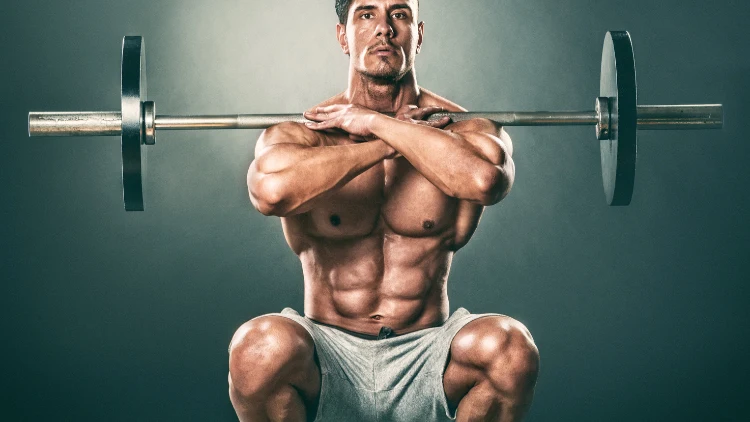
Source: EXTREME-PHOTOGRAPHER via Canva.com11
They primarily target the glutes, quads and hamstrings but the upper back also gets a workout and it also places less strain on the lower back.
How To Perform Front Squat Cross Grip
With the barbell on shoulders and arms crossed with each on the barbell, ensure that the bar always sits in the groove between the clavicle and the neck. It is also important to make sure to keep your elbows high in the movement.
20. Hack Squat
The main difference between the hack squat and the reverse hack squat is the placement of the body away from the machine rather than towards it as with a reverse hack squat.
The torso is fixed in the path set by the machine and hence the ROM is limited by this which makes the quads much more active with less recruitment of the glutes and hamstrings making them challenging to perform.
However, hack squats are not as effective at activating the muscles of the trunk like the back squat.12
How To Perform Hack Squat
Get into position on the machine with hands placed on the handles and feet firmly planted. Ensure that the back is not rounding and that the heels are touching the pad and go as low as is possible to get those quads firing.
21. Leg Press
Leg press is similar to reverse hack in that it employs a machine which limits the range of motion and also the fact that the quads and glutes are the primary movers in this exercise. In addition, it also works the hamstrings and calves.
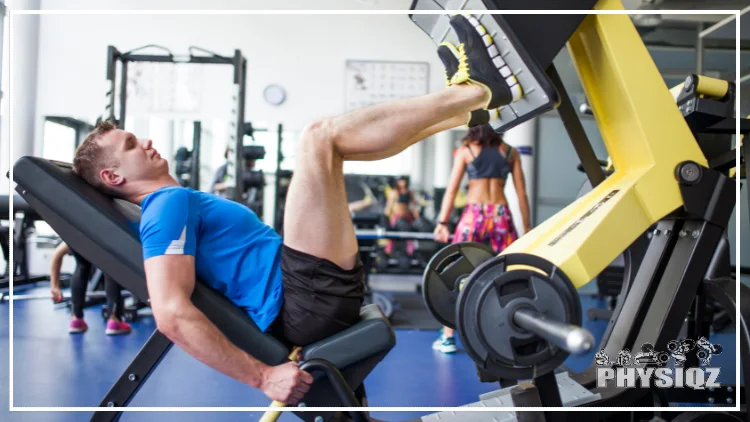
Source: Klubovy via Canva.com13
It builds strength and also helps overcome imbalances in the leg muscles like having hamstrings that are too developed compared to quads. A lifter’s leg press weight often exceeds their squats, and understanding the leg press to squat conversion can assist in estimating their squatting capacity.
How To Perform Leg Press
Get into position on the leg press machine placing the feet low on the platform with toes pointed slightly outwards and go as deep as is possible, but make sure that the back is not rounding.
Do the Reverse Hack Squat Alternatives Work the Same Muscles?
The reverse hack squat primarily targets the quads and glutes (hamstrings and calves as the secondary’s) and this is what the alternatives should ideally work to be considered valid replacements—some alternatives work both these muscles as the main movers while others work on them as the secondary muscle.
For example, the front squat and leg press have the same muscles as the primary movers similar to the reverse hack squat. However, most of the alternatives do incorporate the same muscles as the reverse hack squat in either a primary or secondary capacity.
Hack Squat Without Machine (How To Make a DIY Hack Squat)
It is possible to hack squats without a machine—they are done with a barbell which may be weighted for intensity. It is a low rep exercise keeping the reps between 8 and 10.
- They are done by racking the barbell lower on a squat rack and the lifter stands away from the bar instead of facing towards it as they would with a regular squat.
- Grab the barbell shoulder width apart and with a split stance, un-rack the barbell and step away.
- Perform a squat while keeping the bar close to the legs as would be done sitting back in a chair.
- Return to the standing position with the bar gliding up the legs. The back needs to remain tight, chest and head high and core engaged throughout the movement
Reverse hack squats are an excellent movement with great benefits, however, for those that may not have a machine or may want to introduce some variation in their exercise should opt for the reverse hack squat alternative that is sure target and grow the quads and glutes in a similar fashion as the the reverse hack squat where each develops a strong lower body.
Frequently Asked Questions
Which Is Better: Reverse Hack Squat vs Hack Squat?
It depends on the lifter’s goals and preferences. Hack squats primarily target the quads and are easier to perform. Reverse hack squats are more glute intensive, more challenging and recruit more muscles similar to the back squat. Both are relatively safe exercises.
Is The Back Squat More Challenging Than Reverse Hack Squat Alternatives?
The back squat is more challenging than the reverse hack squat alternatives because it recruits much more muscles than the alternatives.
Can Hack Squats Be Performed With Dumbbells?
Yes, it is possible to be performed with dumbbells in the same way it can be performed with barbells.
How Does the Reverse Hack Squat Compare to the Front Squat: Do They Workout the Same Muscles?
The front squat is one of the alternatives to the reverse hack squat because it recruits the glutes and quads as the primary movers. It also engages similar secondary muscles.
Can I Do Reverse Hack Squat Alternatives at Home?
Most of the alternatives to reverse hack squats above can be done at home, but some things like the leg press and belt squat require large equipment that’s beyond most peoples home-gym set ups.
References
1Wavebreakmedia. Canva. Accessed 15 April 2023. <https://www.canva.com/photos/MADF3M1rD2w-side-view-of-fit-woman-doing-leg-presses-in-gym/>
2Lori Joseph, J. R. (2020, March 31). Activity of Trunk and Lower Extremity Musculature: Comparison Between Parallel Back Squats and Belt Squats. Retrieved 2022, from <https://www.ncbi.nlm.nih.gov/pmc/articles/PMC7126258/>
3Plahutar, Ziga. Canva. Accessed 15 April 2023. <https://www.canva.com/photos/MAEJCG4GjMA-woman-doing-hip-thrust-with-barebell/>
4Walter Krause Neto, T. L. (2019, June 1). Barbell Hip Thrust, Muscular Activation and Performance: A Systematic Review. Retrieved 2022, from <https://www.ncbi.nlm.nih.gov/pmc/articles/PMC6544005/>
5Isabel Martín-Fuentes, J. M.-L. (2020, February 27). Electromyographic activity in deadlift exercise and its variants. A systematic review. Retrieved 2022, from <https://www.ncbi.nlm.nih.gov/pmc/articles/PMC7046193/>
6Walter Krause Neto, E. G. (2020, February). Gluteus Maximus Activation during Common Strength and Hypertrophy Exercises: A Systematic Review. Retrieved 2022, from <https://www.ncbi.nlm.nih.gov/pmc/articles/PMC7039033/>
7Rafael F Escamilla, A. C. (2002, April). An electromyographic analysis of sumo and conventional style deadlifts. Retrieved 2022, from <https://pubmed.ncbi.nlm.nih.gov/11932579/>
8Jason Lake, F. D. (2017, October 24). Effect of a Hexagonal Barbell on the Mechanical Demand of Deadlift Performance. Retrieved 2022, from <https://www.ncbi.nlm.nih.gov/pmc/articles/PMC5969032/>
9mihailomilovonavic. Canva. Accessed 15 April 2023. <https://www.canva.com/photos/MAEJLX8Byw4-front-squat/>
10Jonathan C Gullett, M. D. (2009, January). A biomechanical comparison of back and front squats in healthy trained individuals. Retrieved 2022, from <https://pubmed.ncbi.nlm.nih.gov/19002072/>
11EXTREME-PHOTOGRAPHER. Canva. Accessed 15 April 2023. <https://www.canva.com/photos/MAEJNQYYKHc-barbell-front-squats-lower-position/>
12David R Clark, M. I. (2019, July). Trunk Muscle Activation in the Back and Hack Squat at the Same Relative Loads. Retrieved 2022, from <https://pubmed.ncbi.nlm.nih.gov/28704312/>
13Klubovy. Canva. Accessed 15 April 2023. <https://www.canva.com/photos/MADarb9ZNFU-young-people-in-gym-leg-press-workout/>